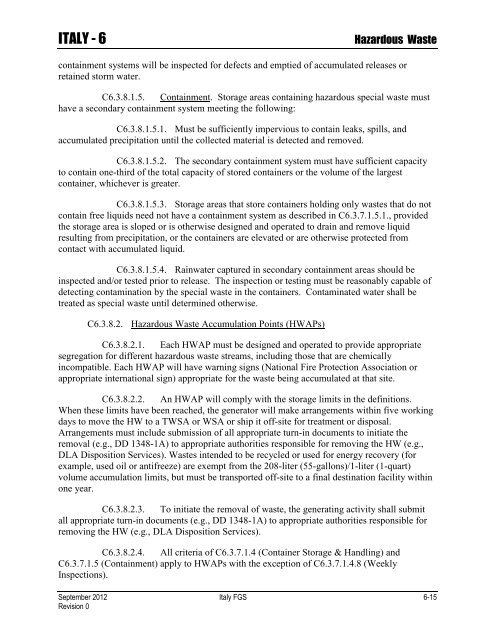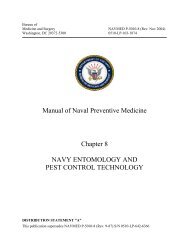ENVIRONMENTAL FINAL GOVERNING STANDARDS ITALY
ENVIRONMENTAL FINAL GOVERNING STANDARDS ITALY
ENVIRONMENTAL FINAL GOVERNING STANDARDS ITALY
Create successful ePaper yourself
Turn your PDF publications into a flip-book with our unique Google optimized e-Paper software.
<strong>ITALY</strong> - 6 Hazardous Waste<br />
containment systems will be inspected for defects and emptied of accumulated releases or<br />
retained storm water.<br />
C6.3.8.1.5. Containment. Storage areas containing hazardous special waste must<br />
have a secondary containment system meeting the following:<br />
C6.3.8.1.5.1. Must be sufficiently impervious to contain leaks, spills, and<br />
accumulated precipitation until the collected material is detected and removed.<br />
C6.3.8.1.5.2. The secondary containment system must have sufficient capacity<br />
to contain one-third of the total capacity of stored containers or the volume of the largest<br />
container, whichever is greater.<br />
C6.3.8.1.5.3. Storage areas that store containers holding only wastes that do not<br />
contain free liquids need not have a containment system as described in C6.3.7.1.5.1., provided<br />
the storage area is sloped or is otherwise designed and operated to drain and remove liquid<br />
resulting from precipitation, or the containers are elevated or are otherwise protected from<br />
contact with accumulated liquid.<br />
C6.3.8.1.5.4. Rainwater captured in secondary containment areas should be<br />
inspected and/or tested prior to release. The inspection or testing must be reasonably capable of<br />
detecting contamination by the special waste in the containers. Contaminated water shall be<br />
treated as special waste until determined otherwise.<br />
C6.3.8.2. Hazardous Waste Accumulation Points (HWAPs)<br />
C6.3.8.2.1. Each HWAP must be designed and operated to provide appropriate<br />
segregation for different hazardous waste streams, including those that are chemically<br />
incompatible. Each HWAP will have warning signs (National Fire Protection Association or<br />
appropriate international sign) appropriate for the waste being accumulated at that site.<br />
C6.3.8.2.2. An HWAP will comply with the storage limits in the definitions.<br />
When these limits have been reached, the generator will make arrangements within five working<br />
days to move the HW to a TWSA or WSA or ship it off-site for treatment or disposal.<br />
Arrangements must include submission of all appropriate turn-in documents to initiate the<br />
removal (e.g., DD 1348-1A) to appropriate authorities responsible for removing the HW (e.g.,<br />
DLA Disposition Services). Wastes intended to be recycled or used for energy recovery (for<br />
example, used oil or antifreeze) are exempt from the 208-liter (55-gallons)/1-liter (1-quart)<br />
volume accumulation limits, but must be transported off-site to a final destination facility within<br />
one year.<br />
C6.3.8.2.3. To initiate the removal of waste, the generating activity shall submit<br />
all appropriate turn-in documents (e.g., DD 1348-1A) to appropriate authorities responsible for<br />
removing the HW (e.g., DLA Disposition Services).<br />
C6.3.8.2.4. All criteria of C6.3.7.1.4 (Container Storage & Handling) and<br />
C6.3.7.1.5 (Containment) apply to HWAPs with the exception of C6.3.7.1.4.8 (Weekly<br />
Inspections).<br />
September 2012 Italy FGS 6-15<br />
Revision 0
















